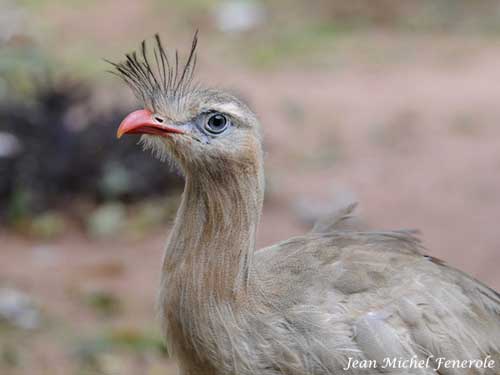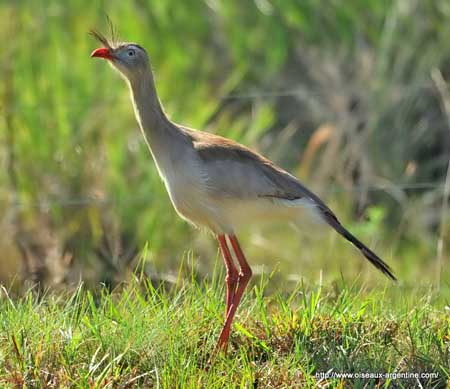
Fr: Cariama huppé
All: Rotfußseriema
Esp: Chuña Patirroja
Ital: Seriema cristato
Nd: Kuifseriema
Sd: Rödbent seriema
Port: Seriema
Photographers:
Jean Michel Fenerole
Photos d’Oiseaux
Philippe et Aline Wolfer
OISEAUX D'ARGENTINE
Texte de Nicole Bouglouan
Sources:
HANDBOOK OF THE BIRDS OF THE WORLD Volume 3 by Josep del Hoyo-Andrew Elliott-Jordi Sargatal - Lynx Edicions - ISBN : 8487334202
BirdLife International (BirdLife International)
Wikipedia, the free encyclopaedia
National Zoo – Smithsonian National Zoological Park
Los Angeles Zoo and Botanical Gardens
Red-legged Seriema
Cariama cristata
Gruiforme Order – Cariamidae Family
BIOMETRICS:
Length : 75-90 cm
Weight : 1500 g
DESCRIPTION:
The Red-legged Seriema is a South American terrestrial bird, sometimes placed in the order Cariamiformes with the Black-legged Seriema (Chunga burmeisteri) which is smaller and crestless.
Here, it is included in the Gruiforme order, being very similar to the birds of this order.
The seriemas are among the largest terrestrial birds of Neotropics.

Adults have greyish-brown upperparts with fine vermiculations. Flight feathers and rectrices are barred black and white.
Underparts are paler, mostly whitish.
Head and neck are greyish. The head shows a conspicuous loose crest on the forehead, and we can see some elongated feathers on the hind neck.
The strong bill is red. The pale yellow eyes contrast with pale blue bare skin on lores, eyebrow and eye-ring. There are black eyelashes on the upper eyelids. Long legs and feet are reddish or red.
Both sexes are similar.
The immature resembles adult with more strongly marked head, neck and back.
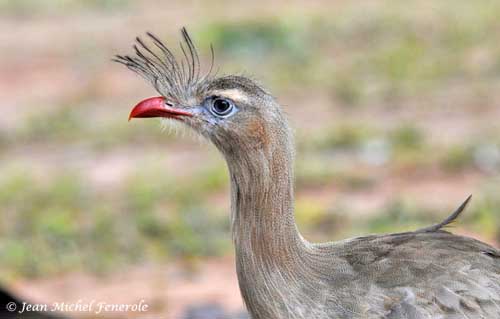
VOICE: SOUNDS BY XENO-CANTO
The Red-legged Seriema’s song is a long sequence of loud yelping calls forming phrases variable in pitch. These calls are described as turkey-like calls or as young dog’s yaps. The sound can be heard over long distance.
It usually sings in the early morning, and these songs are used as territory defence par pairs. One of the mates starts the song, and the other joins it in a duet. Sometimes, a discordant chorus may be formed by several birds singing together.
During the courtship displays, we can hear a squeak, and when an adult is disturbed, it gives a growl.
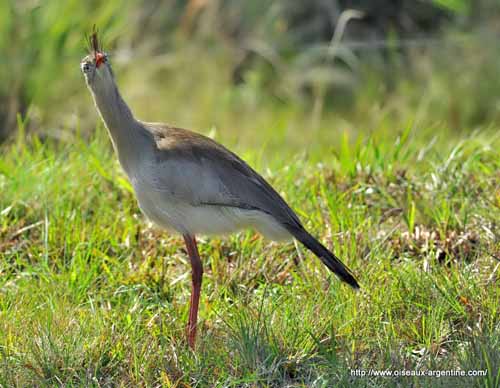
HABITAT:
The Red-legged Seriema frequents semi-open and fairly dry areas such as thorny scrub and semi-arid woodland regions, savannahs and ranchlands, and also hilly grasslands near wooded areas.
This species is very typical in caatinga, cerrado and Chaco. It is visible from sea-level up to 2000 metres of elevation in Argentina and SE Brazil.
RANGE:
The Red-legged Seriema is sedentary in its range, from C and E Brazil, through E Bolivia and Paraguay, to Uruguay and C Argentina.
Some local movements are reported in the Paraguayan Chaco, probably related to temperature.
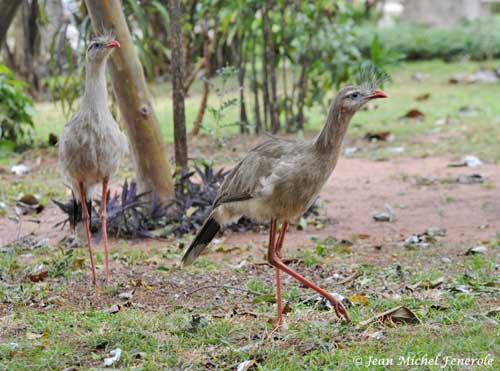
BEHAVIOUR:
The Red-legged Seriema is a terrestrial bird. Its sharp, short front toes and the smaller hind toe, with in addition the long legs, allow it to run quickly.
This species feeds mainly on arthropods and insect larvae, reptiles and small vertebrates including rodents. Occasionally, it also feeds on plant matter such as various crop seeds, fruits and tree gum.
This large bird often feeds alone or in pairs, but also in small family groups according to the season.
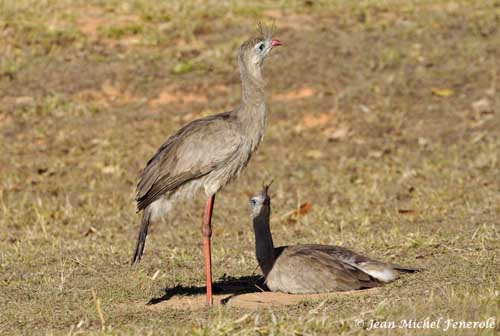
This terrestrial bird feeds by walking slowly, taking preys from the ground or the low vegetation. Its cryptic plumage allows it to remain concealed.
The small vertebrates are caught with the bill, then beaten to death against the hard ground, and finally torn into pieces with help of bill and claws, before to swallow it.
When foraging in groups, they keep close to each other. If disturbed, one of them starts to run, quickly followed by others. However, in order to escape a predator, a bird may hide by lying down quietly behind some log or vegetation, taking advantage of the dull colour of its plumage.
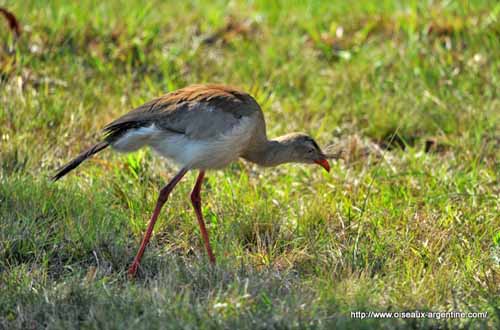
The breeding season involves courtship displays by male. These displays could be those of some Phasianidae species when the male exposes the barred flight feathers by lateral stretching. And when it twists its wings, it acts as the Otididae species.
Another display shows the male performing a ceremonial strutting walk while it raises the nuchal crest with the bill pointing downwards.
At this period, their songs can be heard before dawn.
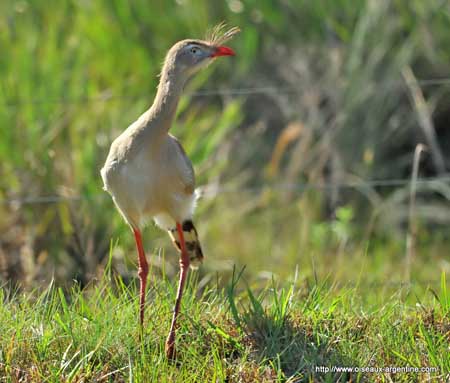
At night, they roost in family groups high in trees, perched side to side on the same branch. Sun-baths and dust-baths are also taken during the day.
They are able to climb the trunks of small trees and jump through the branches with some wing flaps.
FLIGHT:
The Red-legged Seriema only takes flight occasionally and over short distances. This flight is not sustained and consists of burst of rapid wing-beats followed by glides.
It takes flight only to reach high branches for roosting, or to escape a predator.
REPRODUCTION:
The breeding season varies according to the range, but often occurs during the rainy season. This species is solitary nester and monogamous.
The nest is built by both sexes on branches of small trees. This is a round structure made with sticks and twigs, and lined with leaves and mud or cattle dung. It is placed about 1 to 5 metres above the ground.
The female lays two white eggs with some weak markings. The incubation lasts 25-30 days, mainly by female. The chicks have long pale brown feathers on the head. Both parents feed them. They leave the nest two weeks after hatching, and follow their parents on the ground. They fledge at one month. They need 4-5 months to gain the adult plumage.
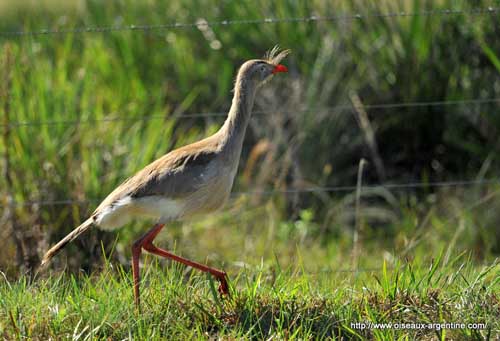
DIET:
The Red-legged Seriema is omnivore but also highly carnivorous. It feeds on insects such as grasshoppers and beetles, but also ants and spiders. It catches numerous small rodents, and also lizards and frogs, and some birds.
It adds plant matter such as seeds, wild fruits, grains and other crops. It is able to catch snakes too, but less than that is often reported.
The small prey items are swallowed whole, whereas the larger preys are torn apart after to be beaten on the ground to kill them.
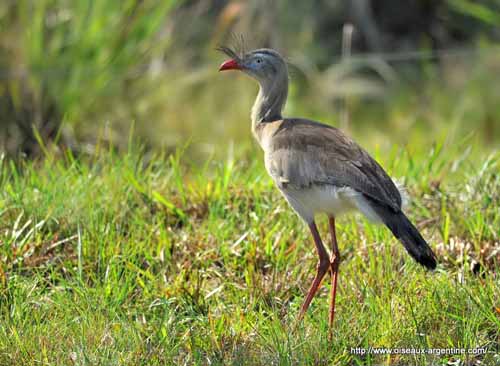
PROTECTION / THREATS / STATUS:
The Red-legged Seriema is a widespread species, but at low densities. It suffers habitat degradation by human developments, but it is able to adapt to the new situation.
According to the range, this bird can be hunted for meat, or protected by farmers because it is a consumer of reptiles and rodents.
They have benefited from deforestation, allowing them to expand their habitat.
This species breeds well in captivity, and is not currently threatened.
